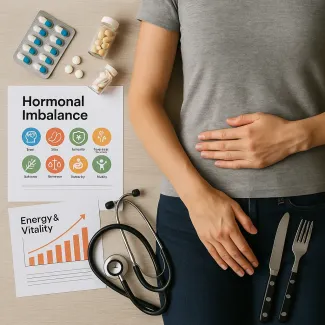
Early Signs of Emotional Burnout and Simple Steps to Reclaim Your Vitality
What Emotional Exhaustion Feels Like and Why It Matters More After 30
Understanding the Nature of Burnout Beyond the Workplace
Burnout is more than just being tired after a long week. It’s a chronic state of emotional, mental, and physical exhaustion that builds up over time and leaves you feeling disconnected, unmotivated, and deeply drained. While often associated with high-pressure jobs, burnout can affect anyone—including stay-at-home parents, caregivers, students, and self-employed individuals. After the age of 30, it becomes even more significant due to shifts in hormonal balance, increased life responsibilities, and cumulative stress.
What distinguishes burnout from regular fatigue is its persistent nature. You don’t recover with a good night’s sleep or a weekend off. You wake up tired, stay tired, and go to bed feeling overwhelmed, even if nothing extreme happened that day.
Common Triggers of Burnout in Your 30s and 40s
While burnout can happen at any age, your 30s and 40s present a unique mix of stressors:
- Career pressure: Striving for promotions, navigating workplace dynamics, or building your own business.
- Parenting and caregiving: Juggling children’s needs, school schedules, or aging parents.
- Financial responsibility: Managing loans, mortgages, and long-term financial goals.
- Hormonal fluctuations: Changes in estrogen, progesterone, testosterone, and cortisol levels impact your mood and energy.
Chronic stress, emotional overload, and poor recovery routines contribute to a dangerous cycle that exhausts your physical and mental resources over time.
Key Physical and Emotional Symptoms of Burnout
Burnout manifests differently in every person. Some of the most frequent physical signs include:
- Constant fatigue despite adequate sleep
- Tension headaches or migraines
- Digestive disturbances, such as bloating, nausea, or irritable bowel symptoms
- Frequent illnesses due to a weakened immune system
- Unexplained muscle pain or tightness
The emotional and cognitive symptoms are just as profound:
- Lack of motivation, even for things you once loved
- Persistent irritability, sadness, or anxiety
- Difficulty focusing, concentrating, or remembering things (aka brain fog)
- Feeling emotionally numb or disconnected from others
- A deep sense of dread when facing everyday responsibilities
The Connection Between Hormones and Burnout
After 30, hormonal changes become increasingly relevant to your energy levels and emotional well-being. Cortisol, your primary stress hormone, rises in response to chronic stress but remains elevated far too long in burnout, impairing the body’s recovery mechanisms.
Other hormones involved:
- Estrogen and progesterone: Imbalances contribute to mood instability and fatigue in women
- Testosterone: A drop in levels can reduce motivation and energy in both men and women
- Thyroid hormones: Burnout often mimics symptoms of hypothyroidism
Restoring hormonal balance is essential to recovering from burnout and reclaiming energy.
Brain Fog, Burnout, and Mental Clarity
“Brain fog” is a popular term for the cognitive fatigue that comes with burnout. It includes mental sluggishness, slower decision-making, and difficulty concentrating. This is often due to:
- Chronic inflammation
- Sleep deprivation
- Nutrient deficiencies, especially B vitamins, magnesium, and omega-3 fatty acids
- Constant exposure to digital screens and overstimulation
Reversing brain fog requires a multi-pronged strategy including rest, nourishment, mental breaks, and focused support for brain health.
Practical Steps to Begin Healing from Burnout
Establish Daily Recovery Rituals
Recovery doesn’t happen passively. It requires intentional rituals that help you disengage from stress and restore your system:
- Morning light exposure to reset circadian rhythm
- Breathwork or short meditation sessions (5–10 minutes)
- Digital detox hours (no screens after 8 p.m.)
- Regular nature exposure, such as walking in green spaces
- Creative activities that stimulate pleasure without performance pressure (drawing, gardening, writing)
The key is consistency, not perfection.
Rebuild Sleep from the Ground Up
Sleep is non-negotiable in burnout recovery. However, burnout often disrupts sleep architecture, leaving you with poor-quality rest. Here’s how to improve it:
- Stick to a consistent bedtime and wake-up time—even on weekends
- Keep the bedroom cool, dark, and silent
- Avoid caffeine after noon
- Consider magnesium glycinate, L-theanine, or glycine supplements (consult a professional first)
- Limit blue light 1–2 hours before bed
Improved sleep supports brain detoxification, hormonal regulation, and emotional resilience.
Use Nutrition to Replenish Depleted Reserves
Chronic stress depletes your body’s nutritional reserves. Restore them by focusing on nutrient-dense foods that support recovery:
- Leafy greens, berries, nuts, and seeds for antioxidants
- Eggs, legumes, salmon, and chicken for B vitamins and protein
- Pumpkin seeds, avocados, and dark chocolate for magnesium and healthy fats
- Hydration with herbal teas and electrolyte-infused water
Avoid high-sugar, ultra-processed, and alcohol-heavy diets which further stress your system.
Move Gently But Consistently
Intense workouts can backfire during burnout. Instead, aim for gentle movement that supports circulation and mood:
- Walking (20–30 min daily)
- Yoga or stretching routines
- Slow strength training with longer rest periods
- Dance, tai chi, or aqua therapy if available
Movement increases endorphins, improves lymphatic drainage, and reduces cortisol.
Reconnect with Purpose and Emotional Fulfillment
Burnout often creates a deep sense of meaninglessness. Restore emotional vitality by:
- Identifying what brings you joy—and making room for it
- Prioritizing relationships that feel nourishing
- Learning to say no without guilt
- Journaling or reflecting on values and long-term goals
- Seeking therapy or coaching for support and perspective
The more you feel aligned with your values, the faster you’ll recover your energy.
Long-Term Strategies for Preventing Future Burnout
Strengthen Your Stress Resilience System
Build daily practices that create long-term emotional stamina:
- Gratitude journaling
- Body scans to tune into physical signals
- Weekly media breaks
- Practicing self-compassion in challenging moments
- Learning the skill of restorative boredom (allowing yourself to do nothing)
These habits protect you from future emotional depletion.
Track Your Energy, Not Just Your Time
Rather than organizing your day around tasks, organize it around your natural energy cycles:
- Identify peak energy times (usually morning for most adults) and reserve them for creative or high-focus work
- Use low-energy times for administrative tasks or rest
- Take 10-minute energy check-ins throughout the day
This method honors your internal rhythms and promotes sustainable productivity.
Audit the Hidden Energy Drains in Your Life
Some things may appear harmless but drain your vitality. Common culprits:
- Unclear boundaries with work, family, or technology
- Cluttered environments
- Toxic relationships or guilt-based obligations
- Excessive multitasking
Conduct a quarterly audit of your physical and emotional energy leaks—and make micro-adjustments.
Supporting Your Gut and Immune System During Burnout Recovery
Why Gut Health Matters More Than You Think
Chronic stress damages the gut lining, alters the microbiome, and reduces nutrient absorption. Symptoms may include:
- Bloating
- Gas
- Cramping
- Food sensitivities
- Brain fog
Rebuild gut health with:
- Probiotic-rich foods: yogurt, kefir, kimchi
- Prebiotic fiber: oats, garlic, leeks, bananas
- Digestive bitters before meals
- Reducing alcohol, refined carbs, and NSAIDs
- Slow, mindful eating
When your gut heals, so does your mood, immunity, and energy.
Strengthening Your Immune System Through Lifestyle
A weakened immune system is a frequent companion of burnout. Boost immunity with:
- Daily vitamin D (from sun or supplements)
- Zinc, vitamin C, and selenium
- Cold exposure (cold showers or face dips)
- Adequate sleep and hydration
- Laughter, play, and human connection
Immunity and resilience go hand in hand.
Burnout and Its Overlap with Anxiety and Depression
Differentiating Between Burnout and Mood Disorders
Burnout can mimic anxiety and depression, but it has distinct characteristics:
| Symptom | Burnout | Anxiety/Depression |
|---|---|---|
| Trigger | Chronic overexertion | May occur without clear cause |
| Mood changes | Irritability, cynicism | Sadness, hopelessness |
| Energy | Exhaustion from activity | Low even without activity |
| Recovery | Improves with rest | Requires deeper intervention |
However, burnout can lead to or exacerbate both anxiety and depression. If symptoms persist, seeking professional support is essential.
Managing Emotional Distress Holistically
Incorporate both internal and external supports:
- Adaptogenic herbs like ashwagandha, rhodiola, or holy basil
- Guided breathing apps or YouTube videos
- Daily sunlight exposure and walks
- Peer support groups (in person or online)
- Limiting toxic social media use
Healing is multidimensional, not linear.
Burnout in Women vs. Men: Different Signs, Same Exhaustion
Unique Burnout Patterns in Women
Women often experience:
- Greater emotional labor
- Pressure to be caregivers
- Hormonal changes across the menstrual cycle, perimenopause, and menopause
- Masking exhaustion with productivity
They may feel guilt for needing rest or shame for not meeting societal standards. Supporting female burnout recovery requires recognizing this burden.
How Burnout Shows Up in Men
Men may experience:
- Internalized pressure to be “strong” or stoic
- Withdrawal and isolation
- Physical symptoms like back pain, digestive issues, or anger
- Reluctance to seek help
Encouraging open emotional expression and safe support spaces helps reverse this trend.
Digital Overload and the Burnout Epidemic
The Impact of Constant Connectivity
Being always available comes at a cost:
- Email fatigue
- Endless notifications
- No mental space to decompress
The dopamine-driven cycle of apps and screens overstimulates your nervous system, leaving you burnt out by noon. Introduce:
- No-phone mornings
- Designated tech-free zones
- Weekly social media sabbaths
- Screen curfews
Your brain needs restorative silence.
Redesigning Your Digital Environment
- Use gray-scale mode to reduce screen addiction
- Remove apps from your home screen
- Turn off all non-essential notifications
- Switch to a basic alarm clock
Less input = more clarity and recovery.
Microhabits That Make a Macro Difference
You don’t need to overhaul your life to begin recovering from burnout. Try these microhabits:
- Drink a glass of water within 10 minutes of waking
- Take three deep breaths before starting each task
- Name one thing you’re grateful for before lunch
- Stand up and stretch every hour
- Declutter one drawer per day
- Say no at least once a week to something non-essential
Small actions, done consistently, lead to big emotional shifts.

